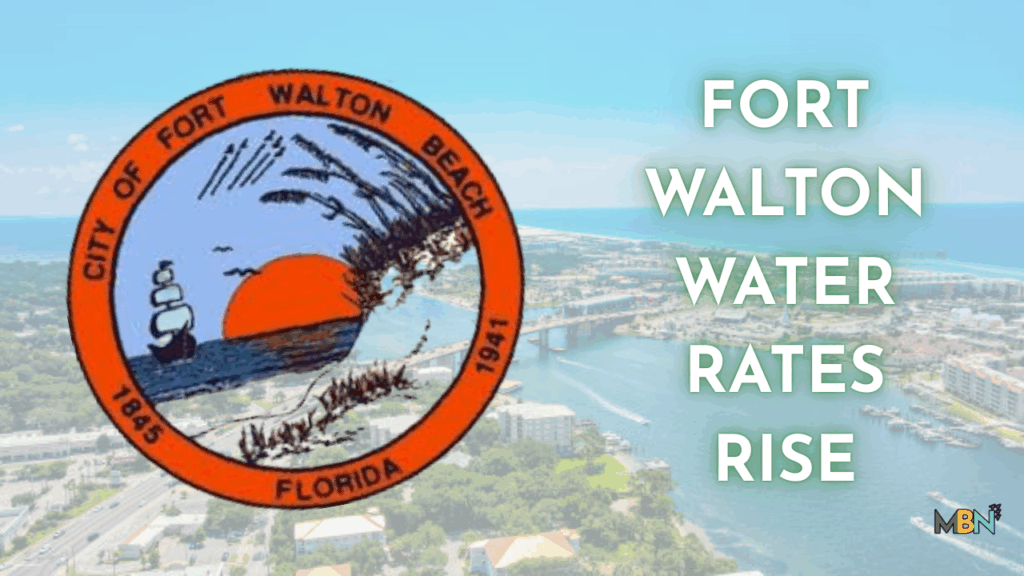
💧 City Council approved 5–7% annual rate hikes starting in 2025 to cover multimillion-dollar shortfalls.
📈 Average household bills will rise by $4–$5 per month, reaching nearly $88 for 4,000 gallons by 2030.
🏗️ The plan funds $6.5 million in pump station upgrades and other projects, but sparked pushback from residents and businesses.
FORT WALTON BEACH — The Fort Walton Beach City Council voted 4-2 on Sept. 9 to adopt a new five-year plan that will raise water and wastewater rates, after consultants warned that without increases, the city’s utility system would slide into multimillion-dollar shortfalls.
The plan, based on a revenue sufficiency study by Raftelis Financial Consultants, phases in annual rate hikes of 5% to 7% beginning in October 2025. Councilmembers Gloria DeBerry and Payne Walker opposed the measure.
The study found that at current rates, the city’s water system faces a $551,700 deficit this fiscal year, climbing to $1.26 million by 2030. Wastewater is projected to fall short by $445,800 this year and by $1.7 million in 2030.
Consultants cited post-pandemic inflation, rising debt service and flat revenues as key drivers. Since 2020, consumer prices rose 18.2% and construction costs 13.9%. At the same time, utility revenues dropped from $11.8 million in 2021 to $11.6 million in 2024 — nearly $1 million less than projected in the last rate study.
“Your revenues at the current rates are not going to be adequate to recover the costs,” consultant Tristian Townsend told the council.
For the average single-family home, the combined water and wastewater bill will steadily rise over the next five years.
Annual increases will average $4–$5 per month. Even with the hikes, Raftelis said Fort Walton Beach’s rates will remain comparable to or below those charged by nearby Mary Esther, Niceville, and Okaloosa County.
Base charges will rise as well. A three-quarter-inch water meter, currently $11.21, will climb to $13.24 in 2026 and $16.71 by 2030. Residential wastewater base charges will increase from $24.57 today to $30.16 in 2026 and $37.35 by 2030.
The plan funds $6.5 million in capital projects over five years, including a new 12-inch force main at Pump Station No. 2 and upgrades to pumps and controls at Pump Station No. 1.
About $2.75 million of the work will be financed through state revolving fund loans, with the remainder covered by utility reserves.
Debt service coverage will remain well above minimums, the study said, and reserve balances will stay at about four months of operating costs.
Utility Services Director Daniel Payne acknowledged the burden but defended the plan. “Bad news isn’t good with time,” he said.
Councilmember Ben Merrell questioned why rates were frozen last year despite rising costs. Payne admitted the 0% increase “put us back.”
Walker voiced skepticism, citing a $700,000 shortfall in last year’s projections. “I’m just hesitant to trust all their other numbers,” he said, adding that with millions in reserves, the city should “sharpen the pencil in advance” instead of raising rates.
One of the sharpest debates centered on households that use fewer than 2,000 gallons per month. The city’s rate structure includes the first 2,000 gallons in the base charge, meaning residents who use less than that amount pay the same as someone who uses the full allotment.
DeBerry objected to the design. “Why are we being punished for those of us who are conservative and use less than 2,000 gallons?” she asked.
Payne said the policy ensures stability for the utility, but acknowledged that low-use customers effectively pay more per gallon.
For example, a resident who uses 1,000 gallons a month pays the same $65.65 combined bill as a household that consumes 2,000 gallons. By 2030, with base charges rising to more than $54 combined, those small users will face higher percentage increases than average families.
Resident Jim Mays argued that property owners bear too much of the burden while visitors and renters use the same infrastructure. He also criticized the city’s $1.7 million annual transfer from utility funds to the general fund.
Jimmy Smith, owner of The Laundry Room laundromat, said his August bill topped $4,200. He told the council that sewer rates in Fort Walton Beach are double or triple those in neighboring cities.
“I’m paying about four times what my competitors are, mostly because of that sewer consumption rate,” Smith said. He urged the city to cap high-volume commercial rates and speed up meter replacements.
Councilmember Bryce Jeter, who introduced the motion, said putting off increases would only force sharper hikes later.
“If we continue to do 0-0-0, we’re going to put this board somewhere in a position where they’re actually going to do a 20%,” he said.
Mayor Nic Allegretto presided as the council approved the plan. The first increases take effect in October.
Collin Bestor is a reporter for Mid Bay News. You can reach him on X @MBNBestor or email him at collin@midbaynews.com.
Register or login with Mid Bay News and never get another pop up on our site!